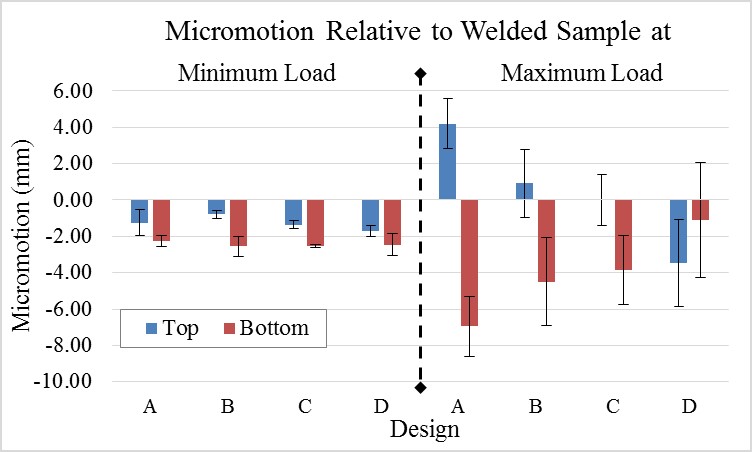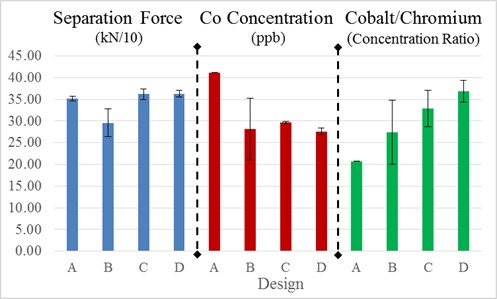Introduction: Artificial joints are one of the most successful treatments for arthritis; however, artificial joint failure is still a critical issue. For example, wear and corrosion at different modular junctions are thought to be instigators of artificial joint failure[1]. To achieve uniform and predictable contact between the stem and head, it is important to optimize the surface structure and properties, along with the angle mismatch, straightness, and conicity of the taper and trunnion[2],[3]. The purpose of our work was to investigate geometric parameters of four different Co-Cr taper junction designs: A, B, and C with fine-machined tapers and coarse-machined trunnions; and D with ground tapers and trunnions. Design A had a negative taper angle mismatch (taper angle > trunnion angle), while C had a positive one. B and D had no taper angle mismatch.
Methods: Cyclic fatigue tests (n=3 for each design) were conducted in PBS solution at 37°C at 10Hz with a loading range from 280 N (minimum) to 2800 N (maximum). Tests were run for 10 million cycles. Displacements between the taper and trunnion were measured at each million cycles with digital extensometers during loading cycles. After 10 million cycles, the force required to separate the head and stem was measured. A head welded to a stem, preventing relative motion, was tested as a control. A composite digital image of each component was created using a Hirox digital microscope and a Bruker optical profilometer[1], through 360o over the trunnion and taper surfaces. Co and Cr ion concentrations in the test fluid were measured by ICP-MS.
Results and Discussion: The changes in average surface roughness and visual appearance showed different trends and magnitudes for tapers and trunnions (Fig. 1). Changes in surface roughness should reflect assembly deformation/damage to, and in-use wear on, the machining marks, as well as metal removal by corrosion and material buildup due to corrosion product deposition.

At the minimum load, all four designs showed "pistoning" while at the maximum load design A exhibited a much higher level of “rocking” relative motion (Fig. 2). The measured micromotion did not appear to reflect changes in surface roughness. The separation force was lower for design B only (Fig.3), which was the smooth taper – rough trunnion combination without any angle mismatch. The trends in Co ion concentrations and Co/Cr ratios (Fig. 3) suggest that design A exhibited the greatest overall corrosion. The change in the Co/Cr ratio is likely a change in mechanism from wear and fretting corrosion to predominantly crevice corrosion.


Conclusions: A combination of experimental techniques can provide a better understanding of taper junction performance. Our results show that the geometry of the taper junction can affect wear and corrosion; however, more study is needed to assess the details of the optimum design parameters. Ideally, taper-trunnion interfaces should neither move relatively to each other while in physical contact nor undergo accelerated corrosion due to the presence of a liquid. It is essential to identify physical contact points, surface roughness changes, types of locking and loosening due to mechanical forces/damage, as well as the source(s) of soluble and insoluble corrosion products.
References:
[1] Matthew Di Prima, Oleg Vesnovsky, Paul Kovacs, Robert Hopper, Henry Ho, Charles Engh, and L. D. Timmie Topoleski, "Comparison of Visual Assessment Techniques for Wear/Corrosion in Modular Hip Replacement Systems", ASTM STP 1591 (2015) in press.
[2] Herbert G. Richter, Gerd Willmann, Martin Wimmer, and Frank Osthues, “Influence of the Ball/Stem-Interface on the Load Bearing Capability of ModularTotal Hip Endoprostheses”, ASTM STP 1301 (1997) 127
[3] Shilesh C. Jani, Willard L. Sauer, Terry W. McLean, Richard D. Lambert, and Paul Kovacs, “Fretting Corrosion Mechanisms at Modular Implant Interfaces”, ASTM STP 1301 (1997) 211-225